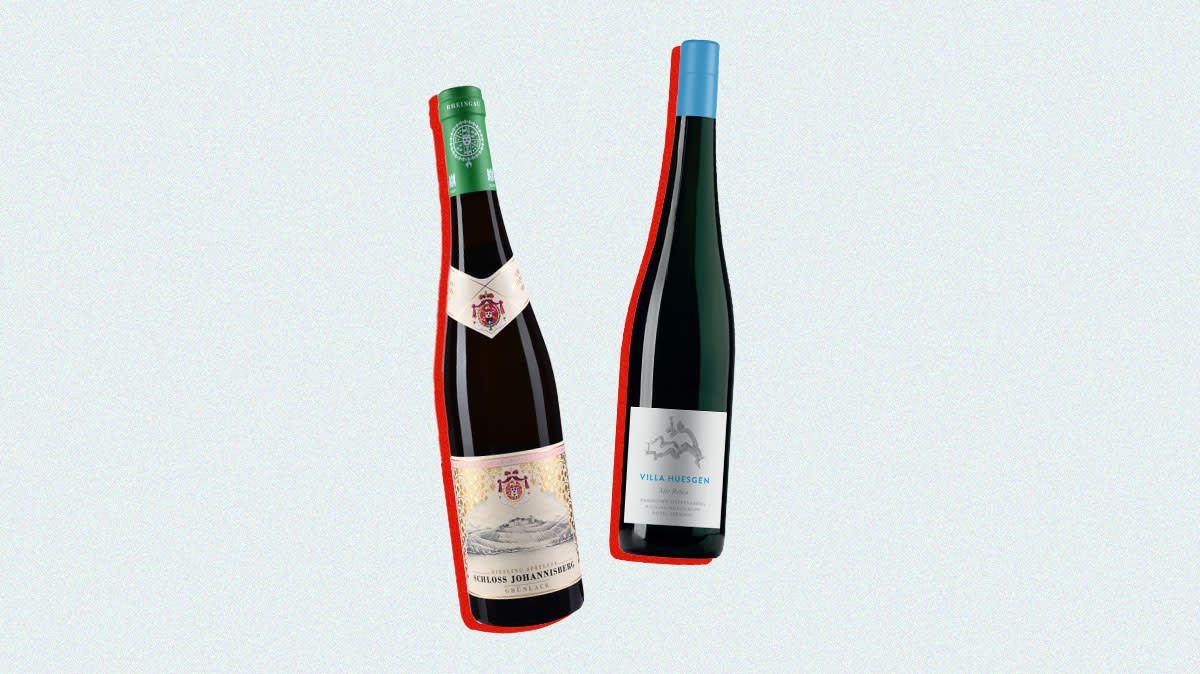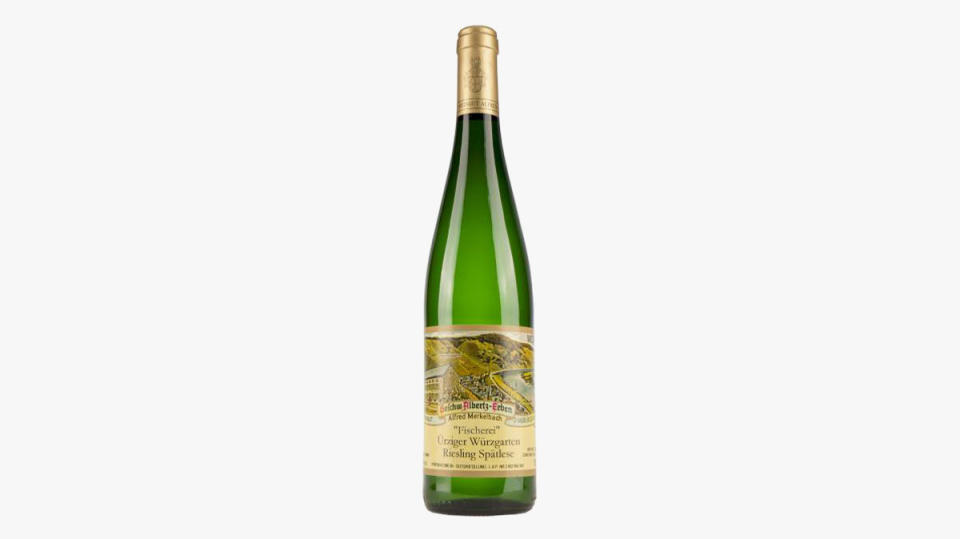The 9 Best German Rieslings to Buy Right Now

If you purchase an independently reviewed product or service through a link on our website, Robb Report may receive an affiliate commission.
Riesling is one of those wines we love but often forget about when opening a bottle of white wine to have with dinner or share with friends as an aperitif. One of the few exceptions is when ordering Thai, Cambodian, Szechuan, or Indian food, because the aromatic and slightly sweet nature of Riesling acts as a perfect foil for the spiciness of these dishes.
More from Robb Report
One of Natural Wine's Biggest Advocates Isn't Into Natural Wine Anymore-Here's Why
Robb Recommends: The Ultra-Potent Vitamin C Serum That Brightens Skin and Fades Scars
10 Pairs of Leather Sneakers You Can Wear With Almost Anything
Riesling is grown in just about every winemaking country including France, Germany, Australia, New Zealand, and the U.S., but some of the best (in our opinion) come from Alsace, France, and a few notable regions in Germany. They also generally represent excellent quality with respect to the quality to price ratio. For this week’s article we decided to focus on Germany and tasted over 50 German Rieslings to compose this list of the nine best.
Germany has 13 main wine regions, and Riesling grows in all of them; the most notable five are Rheingau, Nahe, Rheinhessen, Pfalz, and Mosel. The largest wine growing region, the Mosel, is named for the Mosel River, which runs about 150 miles through the Mosel Valley. Vines are planted on extremely steep slopes that rise upwards from the riverbanks. The soils are predominantly composed of blue slate, which imparts a distinct acidity and minerality to the wines. Rieslings from the Mosel are considered to be some of the best in the world by consumers and collectors alike.
The second largest winegrowing area is the Pfalz region, known for slate, limestone, and sandstone soils—all of which add minerality to the wines but less acidity than the Mosel. The Rheingau is the third largest and has more than 80 percent of its 7,700 acres planted with Riesling. Wines from here are known for prominent acidity and spicy aromas. The Rheinhessen is Germany’s largest region by surface area, but many other fruits and vegetables are grown here in addition to Riesling. Rheinhessen wines are known for their easy drinking nature and moderate acidity. The Nahe region has ancient volcanic soils and because of this, top producers are making excellent wines with marked acidity and smoky minerality. Here are a few to try.
Schloss Johannisberg 2021 Grunlack Riesling Spatlese, Rheingau Germany
Located on the edge of the Rhine River, the Schloss Johannisberg 123-acre single vineyard is beautiful and impressive in and of itself, but even more so because it surrounds the Johannisberg Castle. The soils here are pink to red in color because of iron deposits and therefore impart a strong mineral nature to the finished wines. The Schloss Johannisberger 2021 Grünlack Riesling Spätlese is a brilliant straw color, with aromas of spearmint, jasmine, grapefruit pith, and mandarin zest. It has soft acidity and pleasant sweetness on the midpalate with flavors of yellow peach, citrus blossoms, and a refreshing burst of fresh cut pineapple in the finish.
Dr. H. Thanisch 2019 Erben Müller-Burggraef Bernkasteler Doctor Riesling Kabinett Mosel Germany
Dr. Hugo Thanisch began making wine in 1636, and in the late 18th century his family purchased the coveted Bernkasteler Doctor vineyard perched above the town of Bernkastel. The vineyard is known for its 80-year-old vines, steep slopes, and deep slate soils. This Riesling Kabinett is delightfully sweet with 91 grams of residual sugar per liter and has only 7.7 percent alcohol by volume. It is brilliant straw colored in the glass with aromas of yellow peach, apricot, and nectarine that lead to flavors of white chocolate, caramelized pineapple, and wet river rocks. The acidity is bright, and there’s a touch of salinity in the long, long finish.
Egon Müller 2020 Scharzhofberger Riesling Spätlese Mosel Germany
The only German member of Primum Familiae Vini (First Families of Wine), Egon Müller has been making wine since 1797 and owns a very large plot in the famous Mosel vineyard called Scharzhofberg. All the wines are made at the estate are produced from grapes sourced from this vineyard and its Le Gallais vineyard. The winemaking team lets the grapes ripen and hang for a long time before harvest to make this full-bodied wine. It is medium straw colored with aromas of jasmine, mango, and freesia blossoms that pave the way for flavors of guava, pineapple, and tangerine. There’s great minerality with a touch of saline and a burst of bright acidity at the very end.
Wittmann 2022 Westhofener Riesling Trocken Rheinhessen Germany
The Wittmann family has been making excellent wines for generations, with their impressive, vaulted cellar completed in 1829, but they only made the full switch to biodynamic principles about 20 years ago. Wines are aged in 80 large wooden casks, each holding vino from a single delineated plot of land. The 2022 Westhofener Trocken comes from vineyards in the Westhofen hills known for limestone soils and refreshing minerality. It is straw colored with aromas of white plum and citrus blossom that transition to fresh flavors of mango and white peach on the mid palate. The finish is crisp and acidic with lingering notes of dried savory herbs in the post palate.
Müller-Catoir 2021 Bürgergarten Im Breumel Riesling Pfalz Germany
The Müller-Catoir estate is in Haardt, known for the castle that rises above the village. The manor house was built in neo-classical style in the 18th century and is a lovely place to spend an afternoon tasting amazing wines. Grapes for this Riesling are sourced from the Haardter Bürgergarten Im Breumel vineyard known for its “Haardtsandstein” soils and are grown on vines that are 25 years old. This Qualitätswein is very dry with only 2.7 grams of residual sugar per liter. It has aromas of white peach, mandarin peel, and a whiff of bergamot. It has marked acidity and flavors of dried sage, wet river rock, and kumquat.
Weingut Alfred Merkelbach 2022 Riesling Auslese Urglück Ürziger Würzgarten Mosel Germany
Weingut Alfred Merkelbach is known for growing grapes on very steep slopes above the Mosel River and for its red volcanic and slate soils that impart bracing minerality to the wines. Grapes for this delightful Riesling are grown in the Würzgarden Urglück vineyard, which translates from the original German to “spice garden” and “happiness.” It has enticing aromas of mandarin pith, lemon blossom, and lime zest that translate seamlessly to the palate with additional flavors of kumquat, tangerine, and lemongrass.
Dönnhoff 2022 Tonschiefer Dry Slate Riesling Nahe Germany
Hermann Dönnhoff founded the Dönnhoff estate in the early 1920s, and he passed the brand to Hermann Jr in 1966. Today winemaking is carried out by the original owner’s grandson, Helmut. This tasty and affordable Riesling is designated as Tonschiefer because of the fractured gray slate soil bearing the same name. Weingut Dönnhoff sources its organically grown grapes from the Oberhäuser Leistenberg vineyard in Nahe and then ferments them in a combination of multiple-use large oak barrels and stainless-steel tanks. Brilliant straw colored, this enticing wine has aromas of mandarin peel, citrus blossom, and white peach. In the mid palate it is full bodied with flavors of freshly cut pineapple and apple before the steely, crisp, finish.
Dr. Loosen 2016 Erdener Pralat Grosses Gewächs Reserve Mosel Germany
Most Riesling lovers know the name Dr. Loosen, and many have met the current owner Ernst “Erni” Loosen at wine tastings around the world specifically aimed at both consumers and collectors alike. Weingut Dr. Loosen’s vineyards are located on very steep slopes in the middle of the Mosel Valley, and the grapes used to make this reserve wine are grown on old, ungrafted vines. After fermentation the wine remains on the lees for two years prior to bottling and then is aged for an additional three years before release. Brilliant straw colored in the glass, this stunning wine has aromas of chopped green herbs, mango, and pineapple that transition to ripe peach and pineapple flavors on the palate. There’s a great presence of minerality in the mid palate and a very long finish.
Villa Huesgen 2022 Old Vines Riesling Enkircher Steffensberg Mosel Germany
The Enkircher Steffensberg vineyard was rated as one of the best during Napoleon’s reign and is still highly regarded in the Mosel today. It has both gray-slate and red iron-rich soils, so the resulting wines are known to have excellent minerality. The 2022 is pale straw colored and has aromas of white peach, citrus flowers, and honeysuckle. It is crisp and clean in the mid palate with stark minerality and flavors of lemon zest, passion fruit, and freshly cut pineapple.
Best of Robb Report
Why a Heritage Turkey Is the Best Thanksgiving Bird—and How to Get One
The 10 Best Wines to Pair With Steak, From Cabernet to Malbec
Sign up for Robb Report's Newsletter. For the latest news, follow us on Facebook, Twitter, and Instagram.

 Yahoo News
Yahoo News 









